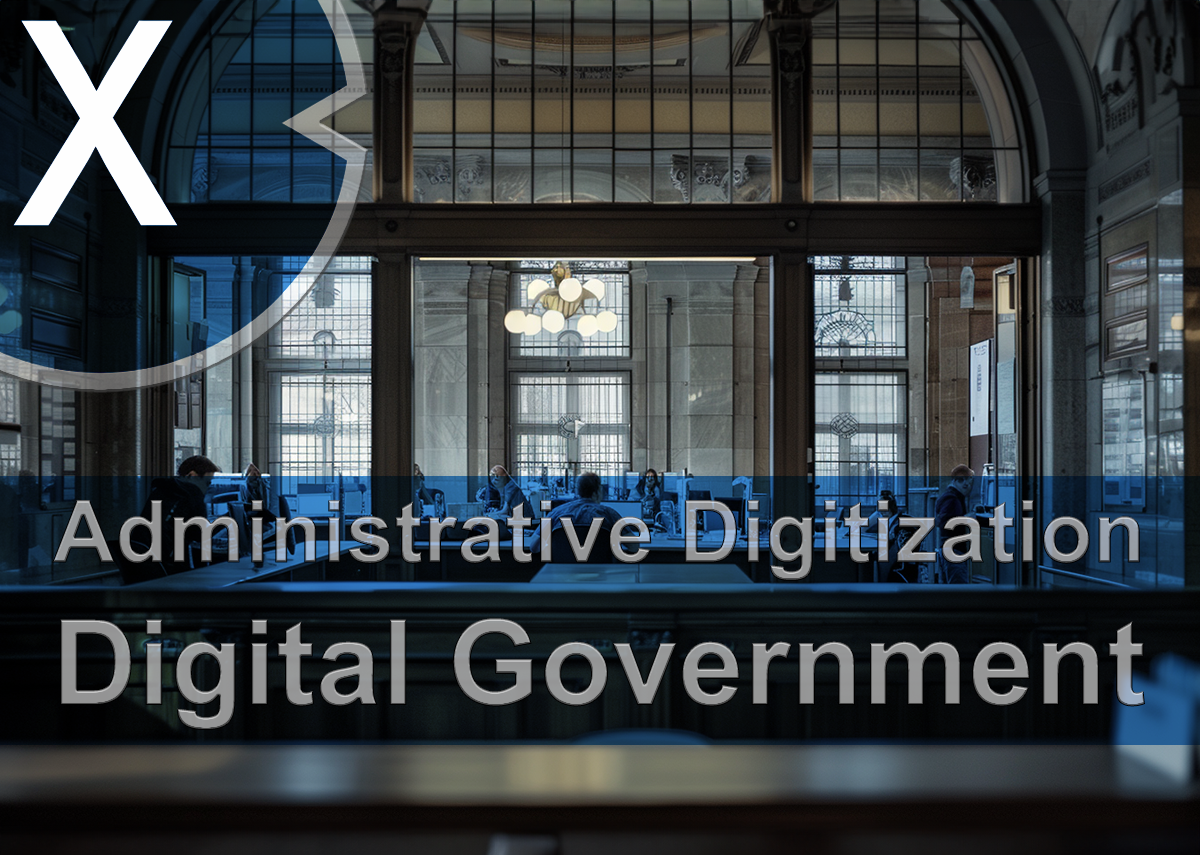
Administrative digitalization: When does administrative optimization rather than administrative modernization make sense? – Image: Xpert.Digital
📊 200 administrative contacts per year: The bureaucracy and challenges for German companies
🏢 Companies in Germany have on average around 200 contacts with public administration per year and the number is constantly increasing. This large number of interactions often leads to significant bureaucratic costs, especially if administrative processes are not fully digitalized. Reducing bureaucracy is therefore one of the three top issues for companies, both at state, federal and EU level.
However, when it comes to reducing bureaucracy, the legislative power and the suffering authorities and administrations are standing in their own way:
In Germany, the digital transformation of administration was primarily triggered by the Online Access Act (OZG) passed in 2017, on the basis of which digital access to administrative services should be implemented by the end of 2022. In February it received broad approval in the Bundestag. Today, a majority in the Federal Council surprisingly rejected the draft law. However, the user-friendly online portals and common standards required for this have only been partially implemented so far (as of early April 2023). In view of the slow pace of administrative digitization in Germany, the digital association Bitkom is calling for a legal right to digital administration when amending the Online Access Act. The new version of the Online Access Act (OZG 2.0) is now available. It went through all instances and the draft law was finally rejected by the majority of the Federal Council on March 22, 2024. It is to be renegotiated (as of June 2024).
There is a clear need to fully exploit the efficiency potential of digital administration solutions for the German economy. The task is to promote and implement efficient digital administrative processes for companies. The question arises as to when administrative optimization makes more sense than complete administrative modernization.
🔍 Administrative optimization vs. administrative modernization
Administrative optimization means analyzing and adapting existing processes to make them more effective and efficient. This can be done by introducing specific digital tools to simplify and speed up individual steps. Examples of this include electronic document management, automated appointments or the digitization of form processes. These measures are often quicker and cheaper to implement than a complete modernization.
Administrative modernization, on the other hand, involves a more comprehensive redesign of administrative processes. This could mean introducing completely new systems and technologies that revolutionize existing structures and ways of working. Modernization projects are typically longer term and require larger investments in new technologies and staff training.
✨ When does administrative optimization make sense?
In situations where existing processes already work relatively well and where specific bottlenecks have been identified, optimization may be the most efficient solution. Smaller adjustments and the integration of digital solutions can often bring quick improvements without the need for major structural changes. This is particularly suitable for specialized administrative tasks where clear problem areas can be identified and specifically addressed.
For example, introducing a digital forms system in a department that relies heavily on paper documents can result in a significant reduction in processing times and error rates. The use of electronic signatures or the automation of notification procedures can also bring decisive advantages.
🔄 When is administrative modernization necessary?
Comprehensive modernization is necessary when existing systems and processes are so outdated or inefficient that small adjustments can no longer bring a noticeable improvement. Existing structures are often no longer able to keep up with the demands of the modern digital economy. In such cases, a fundamental overhaul of the entire process landscape is necessary.
An example of this could be the complete introduction of a digital platform for all administrative contacts of a company. This would mean that companies can handle all interactions with the administration digitally on a central platform - from application to processing and approval. Such systems require extensive integration of various administrative areas and a redesign of previous work processes.
💻 The potential of digital administration
The full potential of digital administrative processes lies in their ability to increase transparency, efficiency and user-friendliness. By harmonizing and standardizing processes, misunderstandings and errors can be reduced, leading to faster and more reliable results. This allows companies to save resources and concentrate more on their core tasks.
For politicians and administrative authorities, this means examining developments in the area of legislation at an early stage and promoting solutions that bring noticeable relief to companies. Political efforts must aim to identify and eliminate or adapt obstructive regulations.
🤝 Practical implementation through cooperation
Another important aspect is the collaboration and exchange of knowledge between everyone involved in the administrative digitalization process. By using specific knowledge about the company's needs, administrative processes can be implemented pragmatically and in a targeted manner. This requires close cooperation between public administrations, business associations and the companies themselves.
Deploying and applying a range of digital management solutions in collaboration with other partners is key. This can range from the use of shared digital platforms to collaborative development projects to create tailored solutions that meet the specific needs of the economy.
🔧 Use of digital technologies
Both administrative optimization and administrative modernization have their place, depending on the specific circumstances and challenges. Short-term optimizations can bring rapid and cost-effective improvements, while long-term modernizations are necessary to enable deep structural changes. The combination of both approaches can help make administration in Germany more efficient and business-friendly.
Through the consistent use of digital technologies and close cooperation between all those involved, the goal of a lean and efficient administration that meets the needs of the economy can be achieved. Early and targeted political support plays a crucial role in the successful implementation of these strategies.
📣 Similar topics
- 📊 200 administrative contacts per year: How companies suffer from bureaucracy
- 💼 Digital instead of paper: German companies demand efficient administration
- ⚙️ Administrative optimization vs. modernization: The best strategy for Germany
- 🌐 Digital administration: A must for Germany’s economy
- 🔄 Fast and cost-effective: advantages of management optimization
- 🏢 Reduce bureaucracy costs: How digitalization can help
- 📉 Raise efficiency potential: This is how digitalization relieves the burden on companies
- 💡 Collaboration is key: administration, business and politics hand in hand
- 🤝 Cooperation for lean administration: Germany's path into the future
- 💻 From paper to platform: efficiency through digital administration
#️⃣ Hashtags: #administrative digitalization #bureaucracy reduction #administrative optimization #administrative modernization #digital administration
🏙️ Why authorities, communities and municipalities find it difficult: Administrative modernization and optimization for cities and rural areas | Kaizen
Why it's difficult for authorities, communities and municipalities: Administrative optimization and modernization for cities and rural areas - Image: Xpert.Digital
Public administrations are subject to strict regulations, laws and bureaucratic processes. This is for transparency, accountability and to ensure fairness and equal treatment. This strict regulation can slow down modernization processes. Companies often have more flexibility and can react more quickly to market changes. They operate in a regulated but more dynamic environment that gives them more scope to innovate and adapt.
More about it here:
🔍🤔 When does administrative optimization rather than administrative modernization make sense?
🏢 The decision between administrative optimization and administrative modernization depends on various factors, including the administration's current needs, resources and objectives. Here are some situations where either strategy might make more sense:
🔍 Management optimization
When it makes sense:
1. Short-term results required
When quick improvements are needed to increase efficiency or solve urgent problems.
2. Limited resources
When resources (financial resources, personnel, time) are limited and large investments in new technologies or far-reaching changes are not possible.
3. Already functioning structures
When existing administrative structures are essentially functioning well, but there are minor inefficiencies or process bottlenecks that can be addressed through fine-tuning.
4. Implement best practices
When it comes to improving existing processes by introducing proven methods and procedures, such as those described by KAIZEN (continuous improvement).
More about it here:
🔄 Administrative modernization
When it makes sense:
1. Long-term and sustainable improvements
When fundamental and long-term changes are sought in order to be prepared for future challenges.
2. Technological upgrade or conversion
When there are outdated IT systems and technologies that need to be replaced with more modern and efficient solutions.
3. Structural problems
When there are major structural deficiencies that cannot be remedied through optimization alone and profound changes are necessary.
4. New requirements
When there are new legal requirements or societal expectations of administration that require the introduction of new processes and technologies.
🌟 Administrative Optimization vs. Administrative Modernization: A Guide
🚀 When deciding between administrative optimization and administrative modernization, the specific situation and objectives of the authority, community, municipality, city or country play a decisive role. Here are some other aspects to consider when making a decision:
1. Time frame 🕰️
- Management optimization: Ideal for short-term improvements and quick wins. Here, existing processes and structures are analyzed and optimized in order to achieve efficiency gains.
- Administrative modernization: Suitable for long-term projects that involve deep changes and upgrades. These projects typically require more time to implement and customize.
2. Resources 💡
- Administrative optimization: Typically requires fewer resources, both financial and human. Existing structures and technologies can often continue to be used.
- Administrative modernization: Requires significant resources, including investment in new technologies, training and possibly external advice.
3. Goals and results 🎯
- Administrative optimization: Aims at quick and measurable increases in efficiency, such as shorter processing times or reduced costs in ongoing operations.
- Administrative modernization: The goal is to fundamentally renew the administration and make it sustainable in the long term. This often includes introducing new technologies, redesigning organizational structures and adapting to new legal requirements.
4. Technological requirements 🖥️
- Administrative optimization: Typically leverages existing technologies and improves their application. It may also include minor technological upgrades.
- Administrative modernization: Often requires the implementation of new technical systems, such as modernized IT infrastructures, automation solutions or e-government platforms.
5. Structural changes 🏗️
- Administrative optimization: Usually no or only minimal structural changes. The focus is on process improvements and increased efficiency within the existing structure.
- Administrative modernization: Drastic structural changes are often necessary to adapt administration to modern requirements. This may include reorganization of departments and tasks.
6. Resistance and change management 🌐
- Administrative Optimization: Typically lower resistance as these are incremental improvements. Change management is important, but often less intensive.
- Administrative modernization: Greater potential for resistance, as profound changes are often met with skepticism. Comprehensive change management is essential here to ensure employee acceptance and participation.
🔍 The choice between administrative optimization and administrative modernization should therefore be made carefully based on the specific needs, resources and goals of the respective institution. A precise analysis of the current situation and a clear definition of the desired results are essential.
We are there for you - advice - planning - implementation - project management
☑️ Industry expert, here with his own Xpert.Digital industry hub with over 2,500 specialist articles
I would be happy to serve as your personal advisor.
You can contact me by filling out the contact form below or simply call me on +49 89 89 674 804 (Munich) .
I'm looking forward to our joint project.
Xpert.Digital - Konrad Wolfenstein
Xpert.Digital is a hub for industry with a focus on digitalization, mechanical engineering, logistics/intralogistics and photovoltaics.
With our 360° business development solution, we support well-known companies from new business to after sales.
Market intelligence, smarketing, marketing automation, content development, PR, mail campaigns, personalized social media and lead nurturing are part of our digital tools.
You can find out more at: www.xpert.digital - www.xpert.solar - www.xpert.plus

